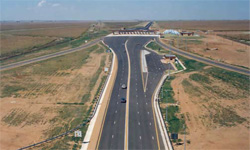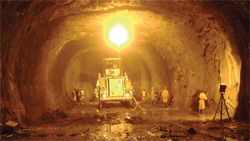|
MARCH 2008 |
 |
|
 |
| Home | | |
Message from CE | | |
Cover story | | |
Major Projects | | |
News | | |
Concessions | | |
Awards | | |
| Currently viewing: Concessions / Next: Awards |
Concessions
TAPPING INTO A GROWING PIPELINE
Concessions are long-term projects that offer contractors an investment and a combined construction opportunity. They normally involve partnerships in which the public and private sectors contract to deliver national infrastructure assets.
 |
| Toll road |
Murray & Roberts has been a key player in the concessions market since the first toll roads were introduced in South Africa. It began with roads in the 1980s – the N1 and N3 – and has since spread to prisons, offices and maybe even power stations.
The Group’s motivation for engaging this market was to maintain a leading position in its core business of major projects in the resources and industrial sector, says Murray & Roberts executive director Sean Flanagan.
Recognising that concessions could not be addressed in the same manner as normal construction projects, Murray & Roberts established a dedicated concessions business unit in 2001, headed initially by Charles Henwood and now by Vaneshree Naidoo.
“Our initial concession project was the Koppies/Kroonstad section of the N1. Since then, the unit has been remarkably successful in winning bids, and similarly successful in completing projects to specifications,” says Charles.
However, Murray & Roberts has found that the valuable potential offered by concessions can easily be eroded if they are not managed with extreme care. While the Bloemfontein prison project was a success in every respect, the N3 was successful as an investment but not as a construction project. Lessons learned from these earlier concessions have become embedded in the ongoing management of these complex and challenging projects.
An important early lesson was that the construction and investment components should be viewed as independent projects and that each should be viable in its own right. “We have to put a lot of our own money and guarantees into a project, and therefore must ensure that the return is commensurate with the investment,” says Sean. “By managing the investment separately from the design and construction, we can make a proper return on both.”
Gautrain is the largest concession secured by Murray & Roberts with domestic and international partners. While the project is proceeding reasonably well, it has highlighted major constraints which make projects of this nature unfeasible for smaller players. One of these is the extraordinary length of time it takes from the initial mooting of a project to the selection of the preferred bidder, and from there to completion of the project. Each of those steps rarely takes less than 18 months, and in the case of Gautrain, the first step alone took five years.
 |
| Gautrain tunneling |
Concessions take a long time to finalise because all costing and financial calculations have to be done up-front and be accurate. A small mistake at the preliminary stage may become enormous when multiplied over 20 to 30 years. Murray & Roberts has tended to focus on major transport infrastructure and industrial concession bids that it has a good chance of winning, and has taken a decision not to bid for Government accommodation projects, having lost three bids in this market.
“We are not unhappy to have lost these bids. In our experience, the internal rate of return for a successful bidder is low and the cost to the client high. Competitors who have not fully appreciated the compounding effects of small mistakes in the tender stage often underbid and then destroy any future relationship with the client,” says Sean.
With the large number of parties in this form of public private partnership, each of whom aims to make a return, the risk profile of concessions is high, and in some cases ultimately unaffordable.
Concessions also tie up large amounts of capital, as they require an equity investment. The Murray & Roberts policy is to be flexible on retaining such investments. In the case of the Bloemfontein prison, once the project was running smoothly, the Group sold its stake to a pension fund which sought long-term investments with stable annuity income streams.
“Once we’d handled all the project risks, and the risks in the capital markets were at the right levels, we decided to sell. Our strategy is to liquidate some investments to make way for the ever growing pipeline of new projects,” adds Charles.
Murray & Roberts is currently bidding for a further six prisons, and though at present there are few other concessions up for tender, Sean believes the concept offers significant opportunity to address South Africa’s growing infrastructure needs.
“There’s enormous scope for rail concessions, both in terms of system and hardware, and there is sufficient passenger traffic to make them viable. But there’s reluctance in Government for concessions, partially due to the long gestation period from concept to fruition. It needs to become a lot shorter and that, in turn, requires Government to dedicate more resources to the process,” says Sean.

